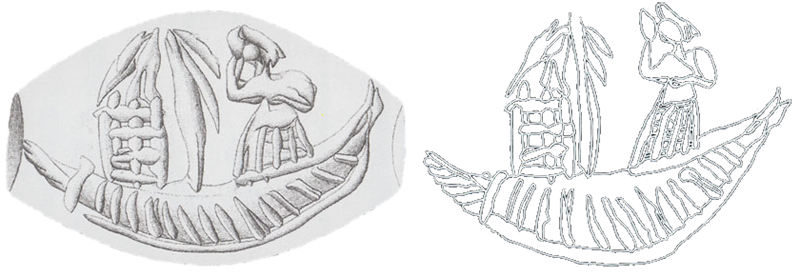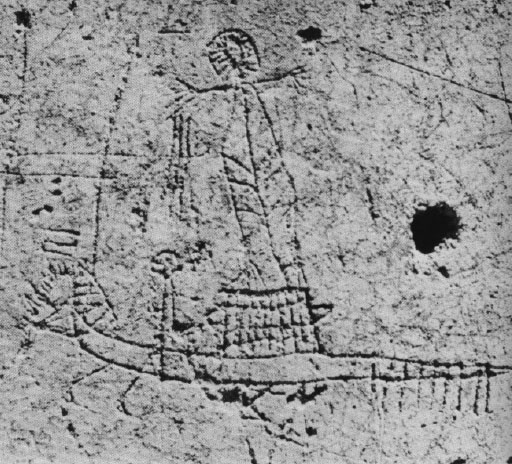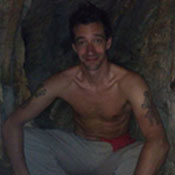Classical Greek mythical traditions are a fascinating fusion of elements springing from both Proto-Greek and Indo-European, as well as Mesopotamian and Anatolian cultures. But one of the strongest currents running through the various traditions originates from the Pre-Greek aboriginal inhabitants of the Aegean, of whom the Minoans were probably the most well-known. A vast array of mythforms and deity names have a profound Pre-Greek flavour, and none more so than the story of Europa.
A very brief re-telling of the tale will aid us in seeing this image: Europa, a daughter of the King of Sidon, is abducted by Zeus in the form of a Bull of Heaven (whose name Asterion, incidentally, is the same as that of his grandson, the Minotaur) and taken to the island of Crete, where he seduces her and fathers on her a child, Minos, the founder of the Knossian dynasty. Images of women riding bulls, and rituals involving either bull-leaping or sacrifice are ubiquitous in Minoan archaeology, but an interesting line of enquiry opens up when we consider the perennial Greek confusion between 'Cretan' and 'Phoenician'.
This is due in part to a telescoping view of history, in which disparate but ancient peoples and events are contracted and combined just as we modern Westerners tend to telescope the thousand years of the medieval era into a single cultural picture. But from the perspective of early Mainland Greeks whose culture had yet to evolve into the flowering of the Mycenaean civilisation, it is likely that visiting Minoans and Phoenicians must have appeared to be the same people: both were highly civilised and arrived as traders in impressive boats which came from southerly directions. Both also spoke a non-Greek language, and significantly both also were famous for dealing in trade of rare purple dyes – indeed the Greek word πορφυρα 'purple' derives from a Pre-Greek (that is to say, probably Minoan) source.
It is also worth noting that the word φοίνικες 'Phoenician' has a Pre-Greek source which Beekes theorises was originally used to designate a people of coastal south-western Anatolia who likely spoke a similar language to the aboriginal Aegeans. Thus we see in this confusion a clarity of Europa's strange origins: from a people called φοίνικες who were inhabitants of the coastline nearest Crete, whose name later became applied to a Semitic-speaking people from Lebanon. This resonates with what we know from Minoan archaeology that Central Crete experienced at the beginning of the Middle Minoan period (around 2000 BC) an influx of Anatolian influences which may have helped transform the society and lead to the rise of the palace system at Knossos. The Phoenician demonym is also closely related to φοίνιξ, another Pre-Greek word referring to, among other things, purple dyes.
(We may also note, in passing, that Kadmos is also subject to this same confusion, not least in part due to his invention of writing, which could equally refer to the transformation of Minoan Linear A into Greek Linear B, or to the adaptation of Phoenician letters into the Greek alphabet. He is cast as Europa's Phoenician uncle, but the variants of his name – Kadmilos, Kadmitos – and his tutelage of the Samothracian Mysteries both disclose a Pre-Greek Aegean origin.)
Interestingly, Greek mythographers often used the name Ευρώπη to mean, metaphorically, 'intelligent, open-minded', as a synonym for γλαυκώπις. This latter epithet was often given to Athena, while the former was in several places attached to the name Demeter, both goddesses with Pre-Greek names. Here we have an explicit link between Glaukos, Athena, Demeter and Europa, all of which bear fairly intimate historical or epigraphic associations with Crete.
Thus we can say with reasonable confidence that the Pre-Greek name of Europa discloses her Minoan origins. This confusion between the earlier Cretan thalassocracy and later Phoenician one can also possibly date our story, since the final stages of the Minoan civilisation endured until around 1450BC, while Phoenicia did not rise until some two centuries later. This association of Europa with two major sea-trading powers of the late Bronze Age Eastern Mediterranean suggests that she may represent a Greek survival of the Bronze Age sacred sponsor of the Minoan sea-trade, and the arrival of Zeus in the story mirrors the arrival of the Greeks into Crete and other aboriginal Aegean territories.
A female deity presiding over such trade, the so-called 'Goddess from beyond the Sea' is evidenced in the archaeology: images on ring-seals from the corpus of the Minoan Epiphany depict a female deity on a boat bringing a shrine onto land, or offering reverence to a sacred tree. The iconography is interesting and worth exploring in detail.
“The complex religious depiction… combines three versions of the epiphany... The goddess is rendered three times: once as a tiny figure hovering in the air, once seated on a built shrine… overseeing two acts of tree-worship carried out by a male and female adorant…and, finally, the goddess is depicted voyaging at sea, rowing or steering a ship with a prow in the shape of a bust of a sea-horse, which is transporting a stepped shrine.”
“The prow of the ship in the shape of a sea-horse finds a direct parallel in the one on the ring from Mochlos, in which the goddess is shown in a seated position… There is a similar scene with a female figure on a ship with a shrine and tree on a seal from Makriyialos [now in the Ashmolean Museum]… the top right (sic – in the seal impression image here it is top left)[can be read] as a tree, and the whole thing as a 'condensed' version of all three stages of the epiphany – that is, the descending female deity, the ritual of tree worship and the voyage at sea...”
Galanakis notes that in 'Goddess from beyond the Sea' scenes, the female deity holds a stereotypical posture of one hand raised towards the face – in the Ring of Minos, this has been varied expertly to suggest the detail of an oar which she uses to propel the ship. He also notes that several depictions of the ship bear a 'Babylonian dragon' prow of uncertain meaning.
As to the general meaning of the 'Goddess from beyond the Sea', Galanakis remarks:
“Most of the representations [of the Goddess]... lead to the assumption that the appearance of a single female figure was not accidental. The Minoans had a long history of depicting solitary female figures in many different contexts... [including] seafaring. The Minoan thalassocracy possibly required the presence of a single divinity, a female divinity in particular... This divinity, the so-called 'Goddess from the Sea', was probably worshipped in specific rituals before or during important sea travels and expeditions faraway.”
In the Amnisos ring we see a possible epiphanic depiction of such a suggested pre-voyage ritual, presided over by a floating female deity who was likely to have been a visionary epiphany. Galanakis continues:
“There is the possibility that the iconographical schema of the 'Goddess from the Sea' may have implied the formation of a prehistoric, mainly Minoan mythology, where the 'Goddess', dressed in Minoan formal attire with the flounced skirt and open bodice, sailed with a mythical ship ready to inaugurate her cult in new places...”
The ritual depicted may have taken place at harbour-sides, and it is significant that the ring was found at Amnisos, the Minoan harbour serving the largest urban area of Knossos, and facing northwards towards Thera and the Cyclades. Galanakis narrates:
“The arrival of the Goddess from different parts of the universe and the introduction of a new cult in new territories may be interpreted [through]... the trading activities of the Minoans... [and the fact that] excavations revealed the Minoan presence and the existence of Minoan settlements at Melos, Thera, Keos, Skopelos, Kythera, Rhodes and Karpathos.”
Interestingly the aspect of cult inauguration chimes well with Europa, for we see her cult in several places associated with former Cretan colonies or with the Minoan-Phoenician confusion, most notably at Thebes and Aegina, and Galanakis connects an 8th century B.C. graffito on a plastered wall in a temple complex at Delos with the survival of this sea-borne image in a local depiction of Britomartis, another Pre-Greek deity with strong associations to Crete.
We note that Britomartis was a nymph of the mountains, an affiliation that resonates with a wider epiphany theme, who, after being chased by Minos across Crete, threw herself into the sea, and becoming tangled in a fisherman's nets, becomes transformed into Diktynna. She is then transported across the sea to Aegina, a Minoan colony, and thus it is possible that this myth, while not likely to represent a perfectly-preserved Minoan original, can perhaps shed some light on wider mythological contexts of this epiphanic sea-borne image.
This image appears to agree strongly with Galanakis' thalassocratic interpretation, the trees and plants adding a dimension of fertility mirrored in the Makriyialos impression:
“[The] female figure is seated with her left hand bent like a farewell gesture... The representation on the Mochlos ring is unique in terms that it presents with a simple but clear way almost everything about the Minoan religious iconography.”
Another seal impression, this time from Ayia Triada, also appears to depict the 'Goddess from beyond the Sea', and include several of the visual conventions we are establishing here, including the sea-horse or dragon-headed prow of the boat and a female figure riding the waves. However, this image shows a couple of differences in that the boat lacks any kind of shrine depiction, and a dynamism suffuses the scene: the lines of the water suggest a rough or choppy sea and the posture of the figure is tense, pulling on an oar in a form expressive of fast movement, of the boat and the figure herself. Galanakis narrates:
“The style is quite rough and sketchy or it is the result of the bad impression of the seal. The figure... depicted inside the ship may be hybrid (birdlike) and not necessarily female... [but] it refers to the almost contemporaneous representations of monstrous figures known from the Kato Zakros sealings.”
It is clear there is no one-to-one correspondence between the mythical image of Europa, or indeed of Britomartis, and the Minoan 'Goddess from beyond the Sea', but it does disclose the extent of survivals from the Bronze Age religions of the Aegean into the Classical age. The wider multi-disciplinary analysis of the subject in my treatise The Minoan Epiphany: A Bronze Age Visionary Culture explores further survivals in figures such as Rhea, and also takes in something of the iconotropy that occurs when images pass across cultural and historical boundaries. This will also be an avenue for further exploration.
Robert S. P. Beekes, Etymological Dictionary of Greek, Brill, 2009
Nota Dimopoulou & Yiorgos Rethmiotakis, The Ring Of Minos And Gold Minoan Rings: The Epiphany Cycle, Hellenic Ministry of Culture Archaeological receipts Fund, 2004
Konstantinos Galanakis, Minoan Glyptic: Typology, Deposits and Iconography, British Archaeological Reports International Series 1442, 2005
Konstantinos Galanakis, The “Goddess from Beyond the Sea”: Iconographical analysis and interpretation of a group of narrative scenes involving female divinities in Minoan-Mycenaean Glyptic, A paper given at the 11th Annual Symposium on Mediterranean Archaeology (SOMA 2007), Istanbul, 24-29 April 2007
Nanno Marinatos, Minoan Kingship and the Solar Goddess: A Near Eastern Koine, Columbia University, 2010
Martin P. Nilsson, The Minoan-Mycenaean Religion and Its Survival in Greek Religion, Biblo & Tannen Incorporated, 1950
Bruce Rimell, Europa Untouched: Two Minoan Honey Images, 2010, url: http://www.biroz.net/words/europa-untouched.htm , retrieved September 2013
Bruce Rimell, The Minoan Epiphany: A Bronze Age Visionary Culture, 2013, url: http://www.biroz.net/words/minoan-epiphany/index.htm , retrieved September 2013











 RSS Feed
RSS Feed






